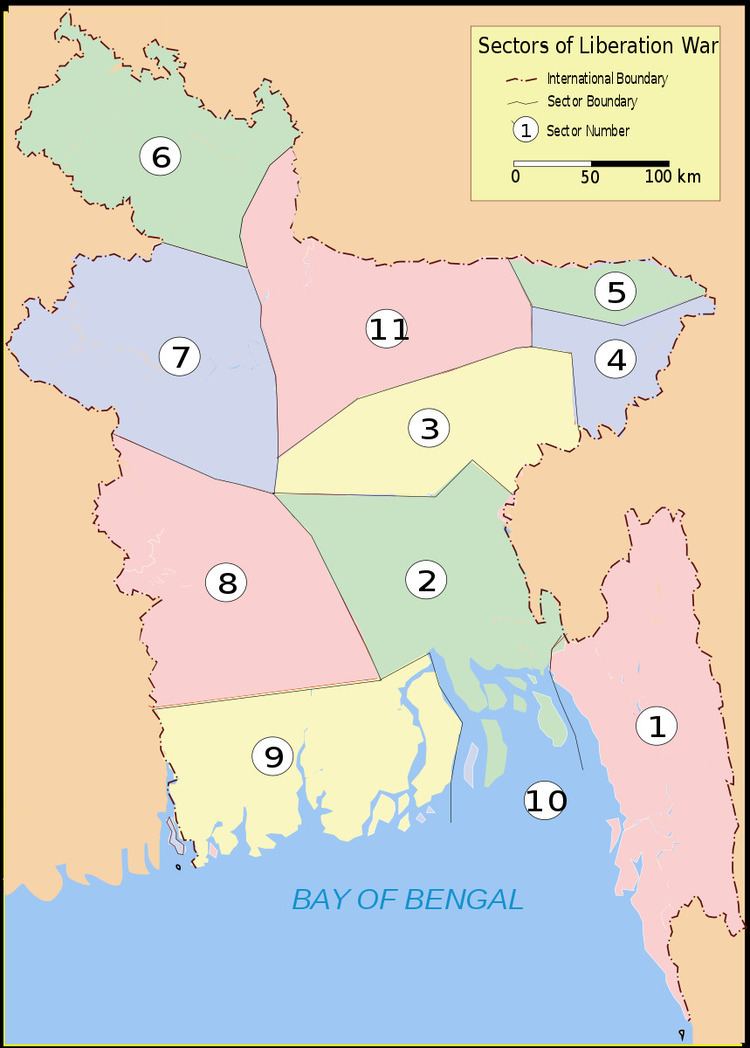 | ||
During Bangladesh War of Independence the Bangladesh Forces (not to be confused with Mukti Bahini) were divided in the geographical area of Bangladesh into eleven sectors. Each sector had a sector commander who directed the military operation further coordinated through several sub-sectors under sub-sector commanders who fought along with their troops and civilian resistance fighters.
Contents
Bangladesh Sector Commanders Conference
The history of the Bangladesh liberation war dates back to April 1971 when it began its inception with the title of Bangladesh Forces during the first Bangladesh Sector Commanders Conference held in the week of July 11–17, 1971. It was at this conference during which time BD Forces was organized and formed for the independence struggle. It was significant in the light of its official creation and formation as Bangladesh Forces, its command structuring, sector reorganization, reinforcement and appointing war commanders was its principal focus.
This conference was presided over by the Prime Minister of Bangladesh, Tajuddin Ahmed, and General M.A.G. Osmani, during which General Muhammad Ataul Gani Osmani received his promotion from Colonel and was reinstated from retirement to active duty into the Armed Forces of Bangladesh as its senior most official. General M.A.G. Osmani had thereby been appointed Commander in Chief of all Bangladesh Forces and Group Captain Abdul Karim Khandker,psa appointed as Deputy Chief of Command of all Bangladesh Forces . Principal participants of this conference was Squadron Leader M. Hamidullah Khan, Major Ziaur Rahman, Wing Commander M Khademul Bashar, Major M. A. Jalil, Captain Haider, Lt. Col. Abdur Rab.
Structure
The Bangladesh Forces was organized for the war in 1971 into three brigades in 11 sectors, with BDF HQ situated at 8 Theatre Road, Calcutta, West Bengal. Bangladesh interim government of July 11, 1971 appointed Col. M A G Osmani as Commander in Chief. Lt.Col Rab was appointed as Chief of Bangladesh Army Staff. In this meeting, Bangladesh was divided into Eleven Sectors under Sector Commanders.
Sector Commanders directed the guerrilla warfare. For better efficiency in military operations each of the sectors were divided into a number of sub-sectors. On November 21, 1971 Bangladesh Forces under Indian Army formed an allied command in which India took surrender of Pakistani forces on December 16, 1971. The table below provides a list of the sectors along with the area under each of them, the names of the sector commanders and the names of sub-sectors.
The 10th Sector was directly placed under Commander in Chief and included the Naval Commandos and C-in-C’s special force.These commandos were later absorbed into the Bangladesh Navy. Sector Commanders directed the guerrilla warfare against West Pakistani forces.
Indian participation
The Bangladesh Forces received assistance from the Indian authorities soon after hostilities started. On November 21, 1971, when the natural climate was more adaptable and by which time all Bangladesh Forces had severely under-cut the strength of the West Pakistani Forces, a demand of the Government of India was conceded to by the Bangladesh Government-in-exile in Calcutta, India, which was handing over the full command and authority of its operations to the Indian armed forces to command the war. The Indian Army entered Bangla Desh through air and land. The Pakistani force already morally broken and militarily devastated by the BD Forces, agreed to a cease fire without defiance in about one and a half weeks, on December 16, 1971. Deputy Chief of Command Group Captain Abdul Karim Khandker,psa has taken part as a representative of Bangladesh Government and freedom Fighter group.
The cease fire was switched to a surrender by the Indian government which the Commanding General of the Pakistan Army Eastern Command signed. Victory was declared by the Indian authorities and all prisoners of war including combat material were taken to India, with the Indian army remaining inside independent Bangladesh another three months until mid-March 1972. Bangladesh Forces were ordered for demobilization on January 29 under the direction of General M.A.G Osmani in final Sector Commanders Conference at the old Police HQ at Mintu Road, Dhaka, effective 14 February 1972.
